1. Canadian team gets 2,098 mpg in supermileage competition
The average Australian car travels about 15,000 km/yr.
This car would consume only 16.5 litres per year!

Students from Canada have designed and built a car that is capable of achieving a fuel efficiency of 2,098 mpg (0.11 l/100km). The team from Quebec’s Université Laval (University of Laval) was competing in the 36th SAE Supermileage competition. It is the university’s second straight win at the event.
Cars in this event must be single-person, single-cylinder and powered by a four-cycle engine, and are powered by the same iso-octane fuel. The world record is actually held by ETH Zurich’s hydrogen-powered PAC-Car II, which achieved 12,666 mpg (0.02 l/100km) in 2005.
Thanks to John Davidson for this item.
2. New evidence of mass extinction
Gerardo Ceballos, one of the study’s authors and a professor at the Institute of Ecology at the National Autonomous University of Mexico, comments:
- “We know that we have been destroying habitat; deforestation is huge,” Ceballos told ThinkProgress. “Thousands of animals are being killed every year for trade, and also by pollution. All these factors, these human factors, are major, and now we have climate change.”
The scientists used very conservative criteria and only studied vertebrates. They expected to find no evidence of a mass extinction.
- According to the IUCN Red List, an international monitoring body, 22 percent of the world’s mammal species are known to be globally threatened or extinct. Since 1500, 76 mammals have disappeared. Nearly a third of the world’s amphibian species are threatened or extinct, and as many as 159 species may already be extinct. At least 38 amphibian species are confirmed to be extinct, while another 120 species have not been spotted in recent years and have possibly died off. (It can take years or even decades to confirm extinction, which is one reason the extinction rate in the study is considered conservative.)
3. India has upped the ante on solar
Prime Minister Narendra Modi and the Indian Cabinet have approved increasing the country’s solar target by five times to a goal of reaching 100 gigawatts by 2022, up from 20 GW.
- The new solar capacity will be nearly split between residential and large-scale solar projects, with some 40 GW expected to be generated from rooftop installations and the remaining 60 GW coming from larger, grid-connected projects, such as solar farms.
There are “estimates that India will install more solar this year than Germany, some 2.7 GWs, and in doing so become one of the top five solar markets globally, after China, Japan, the US, and the UK.”
4. Labor needs to sharpen up on climate change
A grassroots network of ALP members called the Labor Environment Action Network are pushing the party to adopt clear climate targets and show Australians the party is acting on climate change.
Felicity Wade on behalf of the group:
- “Make this a conviction issue, take it out of the realm of tactics and then argue it to the Australian people, explain how it’s going to be better for all of us in the long run and stand toe-to-toe with [Tony] Abbott and make it a point of difference.”
They worry that the platform being taken to the national conference lacks specificity and are arguing for an adoption of targets proposed by The Climate Authority.
That’s about the least we should expect.
5. China getting serious about climate change
China is looking at different kinds of measures, for example, it aims to reduce its carbon intensity, the amount of carbon dioxide emitted per unit of GDP, by 60 to 65 percent of 2005 levels by 2030. This graph charts its progress:

Overall, though, emissions are expected to peak only in 2030. By then China’s GDP will be about $10,000 per capita.
- The United States peaked when its GDP per capita was at about $40,000. The EU peaked when its GDP per capita was at about $20,000, while some other developed countries still haven’t peaked at $50,000.
Also:
China’s emissions per capita when it peaks will be no more than 10 tons greenhouse gas (GHG) per capita. The U.S. peaked at 19.5 tons GHG per capita, while Germany peaked at 14.1 tons GHG per capita and the UK peaked at 11.3 tons GHG per capita.
Furthermore:
- China will need a greater annual reduction rate of carbon intensity than most developed countries to reach its commitment of reducing carbon intensity by 60 to 65 percent by 2030. China would have to maintain a 3.6 to 4.1 percent annual reduction rate from 2005 to 2030.
That’s a little more than the US and the EU will need to meet their targets. Unfortunately none of them are going fast enough to produce a safe climate.
6. Here in Oz
Graham Readfearn reports on a serious(?!) proposal from a bunch of Liberal backbenchers to review basic climate science, by scientists not tainted by knowledge of climate science.
Abbott continues his war on renewables and wind in particular. I’ll say more in a separate post.


The Canadian car is not very practical but it does make you wonder what could be achieved if ultra light cars that depended on accident avoidance instead of accident protection could achieve.
Yes, John, we feel we need to wrap a tonne of metal around us for safety reasons. One would think the time is not far away when we could have uncrashable if not driverless cars.